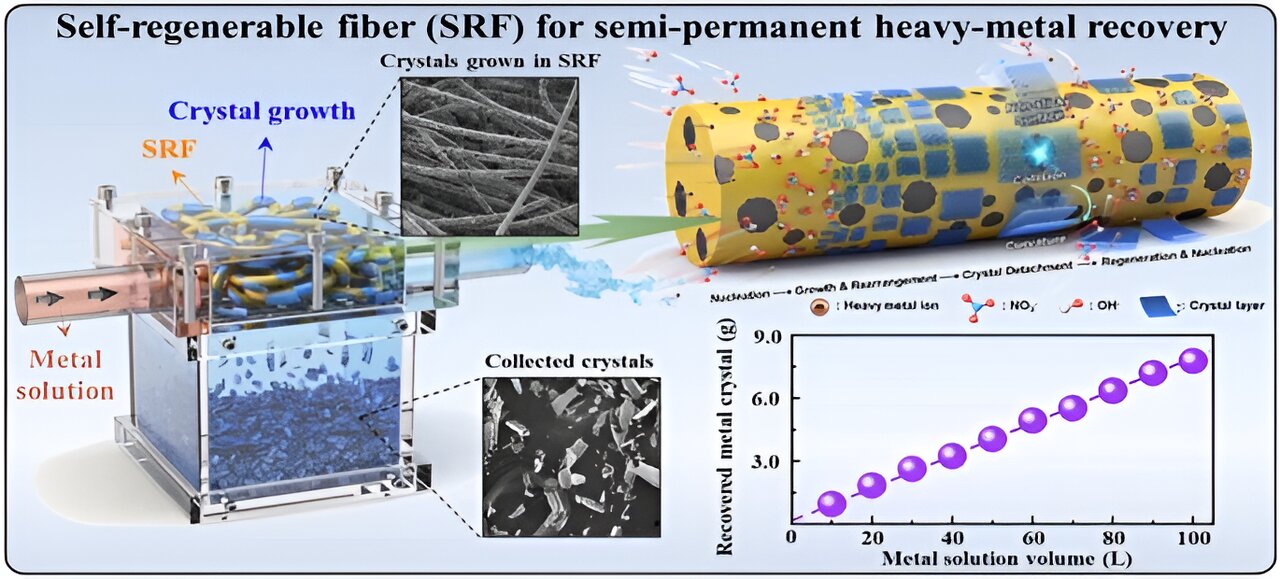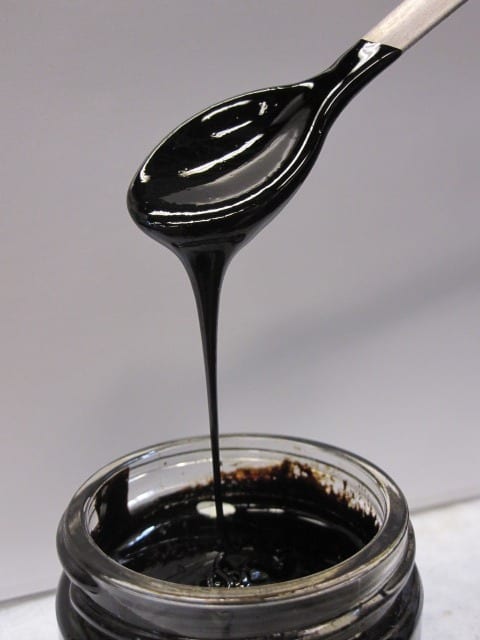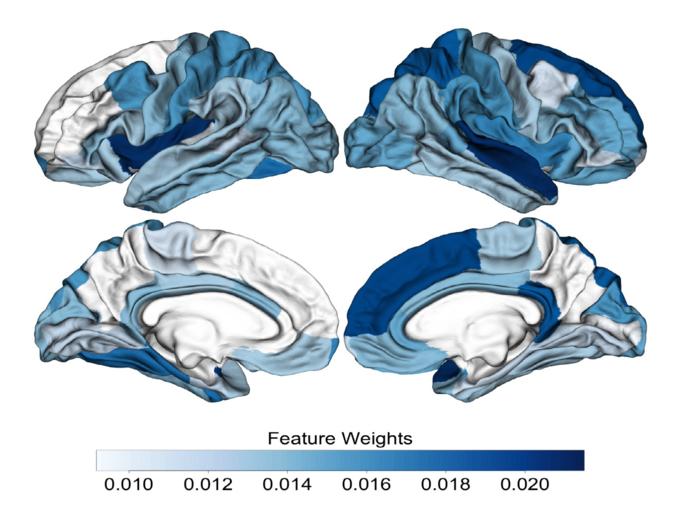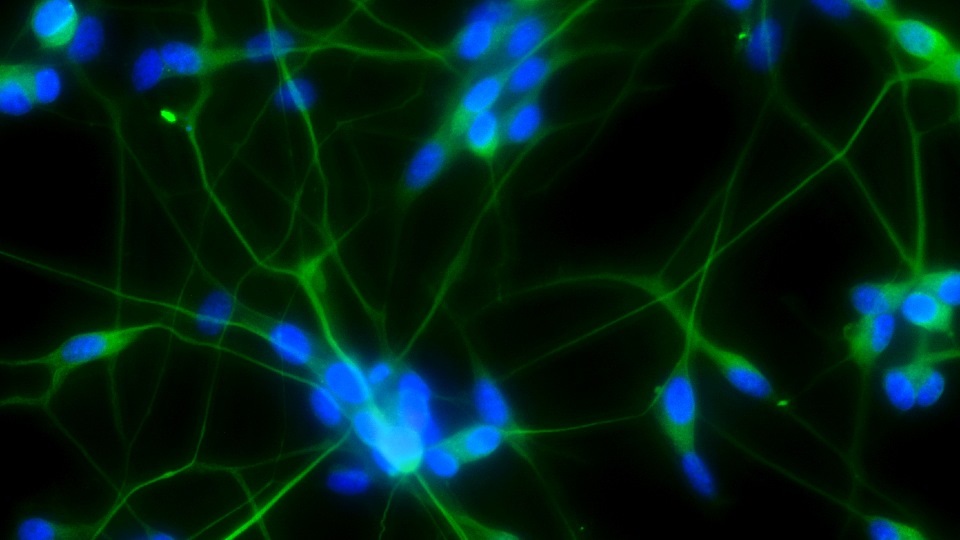
Fig. 1. Structure and concept of SRF. (a) Schematic illustration of fabricating PAN/PMMA fibers using a dry-jet wet spinning machine. The diameter of the PAN/PMMA fiber was readily controlled by regulating the injection rate and rolling speed. Information on the diameter of the fibers is summarized in table S1. Illustrations representing the physicochemical structure of (b) the PAN/PMMA fiber and (c) the SRF. (d) A series of courses for self-regeneration in which crystal layers are repetitively formed-detached on an SRF surface. The heavy metal ions and counter-anions induced nuclei for crystal growth, resulting in the formation of crystal layers. The crystal layers are self-detached from the SRF surfacevia collisions with each other, non-sticky surfaces, and the curvature of the fiber, and new crystals grow on the SRF surface in which the crystal layers are detached. (e) SEM image of the SRFs immersed in 1,000 ppm copper nitrate solution for 1 h. The three self-detachment aspects of the copper crystal layer, i.e., collision between the crystal layers, a non-sticky surface, and curvature of the SRF, were observed. Scale bar: 100 ?m (f) Snapshot images show the course of self-detachment of crystal layers from an SRF via (g) non-sticky surface formation, (h) collision, and (i) surfacecurvatureduring an elapsed time of 55 min (Ci of 100 ppm and no pH adjustment). Scale bar: 200 ?m.
Development of fiber-based adsorbent material to recover valuable metals from industrial wastewater. Minimize toxic chemicals and energy use by eliminating the need to replace and regenerate materials.
Technology to recover valuable metals from wastewater generated in various industries such as plating, semiconductors, automobiles, batteries, and renewable energy is important not only for environmental protection but also for economic reasons. In Korea, chemicals are mainly added to wastewater to precipitate heavy metal ions in the form of oxides, but accidents such as leakage of hazardous chemicals have occurred one after another, so it is necessary to develop more eco-friendly technologies.
Against this backdrop, the Korea Institute of Science and Technology (KIST) announced that Dr. Jae-Woo Choi’s team at the Water Resource Cycle Research Center has developed a fiber-like metal recovery material that can recover metal ions in water by adsorbing and crystallizing the metal, and the recovered metal crystals can desorb and regenerate themselves.
KIST research team has developed a semi-permanent adsorption material by utilizing the phenomenon that metal ions in water crystallize when certain chemical functional groups are fixed on the surface of a fiber-like material and introducing a technology to remove the formed crystals. When tested with copper ions, the maximum adsorption amount of existing adsorbents is only about 1,060 mg/g, but by utilizing the developed material, near-infinite adsorption performance can be secured.
In addition, existing high-performance adsorbents are in the form of small granules with diameters ranging from a few nanometers to tens of micrometers, making it difficult to utilize them underwater, but the metal recovery material developed by the KIST research team is in the form of fibers, making it easy to control underwater, making it easy to apply to actual metal recovery processes.
“Since the developed material is based on acrylic fibers, it is not only possible to mass produce it through a wet spinning process, but also to utilize waste clothing,” said Dr. Jae-woo Choi of KIST. “The wastewater recycling technology will help reduce the industry’s dependence on overseas sources of valuable metals that are in high demand.”
Original Article: Development of eco-friendly and low-energy self-regenerative fiber material to recover valuable metals from industrial wastewater
More from: Korea Institute of Science and Technology
The Latest Updates from Bing News
Go deeper with Bing News on:
Self-regenerative fiber material
- Quantum fiber optics in the brain enhance processing, may protect against degenerative diseases
The effects of quantum mechanics—the laws of physics that apply at exceedingly small scales—are extremely sensitive to disturbances. This is why quantum computers must be held at temperatures colder ...
- Self-Healing Materials Market Estimated to Reach US$ 15.57 billion by 2032, Fueled by Infrastructure Surge in Developing Economies
The self-healing materials industry size estimated at US$ 1.61 billion in 2022 is anticipated to grow at a CAGR of 25.5% from 2022 to 2032. Materials that are capable of self-healing are stimulated by ...
- Self-assembling synthetic cells act like living cells with extra abilities
For the new study, scientists from the University of North Carolina at Chapel Hill developed synthetic, self-assembling cytoskeletons, built out of DNA, peptides and other genetic material. “DNA does ...
- Extracting high-purity gold from electrical and electronic waste
Korea relies on imports for most of its metal resources, and in recent years, due to resource depletion and rising raw material prices, 'circular resources' that recycle waste metal resources have ...
- Cob Houses, Rammed Earth, and Hemp Mixtures: These Eco-Friendly Building Materials Start in the Soil
Firms that specialize in construction with sustainable materials shed some light on the misconceptions around their work (no, it’s not going to just wash away in the rain) ...
Go deeper with Bing News on:
Metals recovery
- Madison Metals Engages Market One Media Group for Marketing Services
Madison Metals Inc.(“Madison” or the “Company”) (CSE: GREN) (OTCQB: MMTLF) (FSE: 4EF0) is pleased to announce that it has entered into a media services agreement (the "Agreement") with Market One ...
- PyroGenesis Kicks Off New European Distribution Strategy with Contract to Supply Spanish Aerospace Entity with Titanium Metal Powder
The contract was possible as a result of recent changes to the Company’s European metal powder distribution strategy, whereby the Company and Aubert & Duval mutually agreed to end their distribution ...
- Q2 Metals Announces Completion of Drill-Core Re-Evaluation for the Cisco Lithium Property, James Bay Territory, Quebec, Canada
Q2 Metals Corp. (TSXV: QTWO) (OTCQB: QUEXF) (FSE: 458) ("Q2" or the "Company") is pleased to announce that the Company recently completed a review of the drill core from the drill program conducted by ...
- Private equity takeover for metals recycler
The firm said Enablelink processes more than 300,000 tonnes of material per year and operates from three production sites in the acquisition, processing ...
- Market Dynamics and Precious Metal Trends: A Comprehensive Analysis
Exploring the intricate patterns of S&P 500's fractal charts and current shifts in market sentiment, alongside crucial updates on commodities like Gold, Silver, and Oil. What do these trends forecast ...










